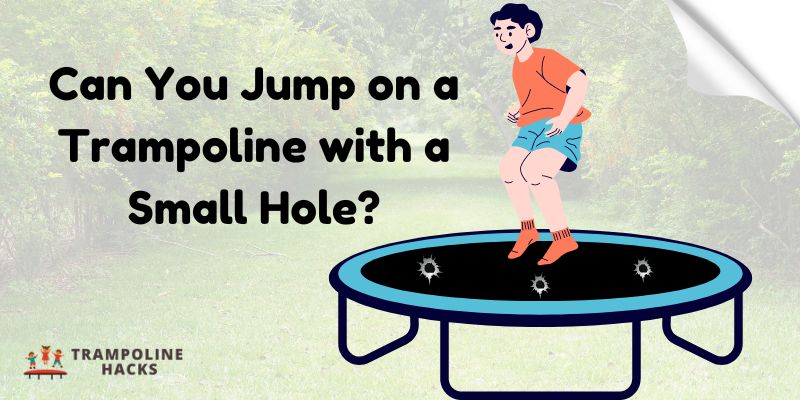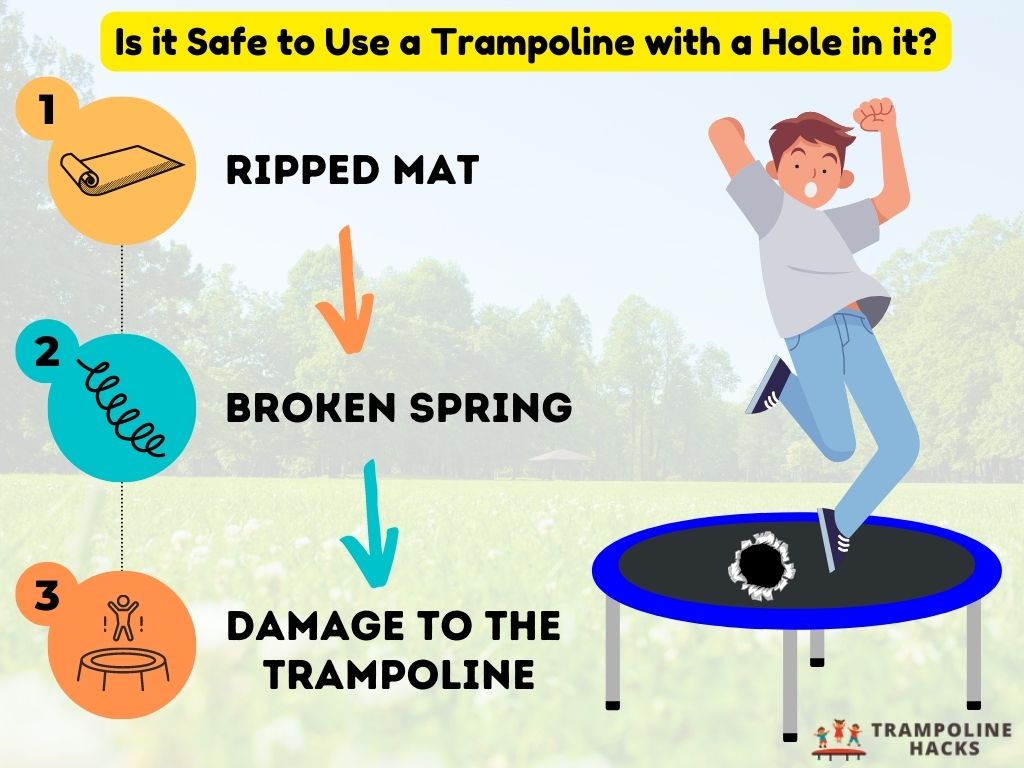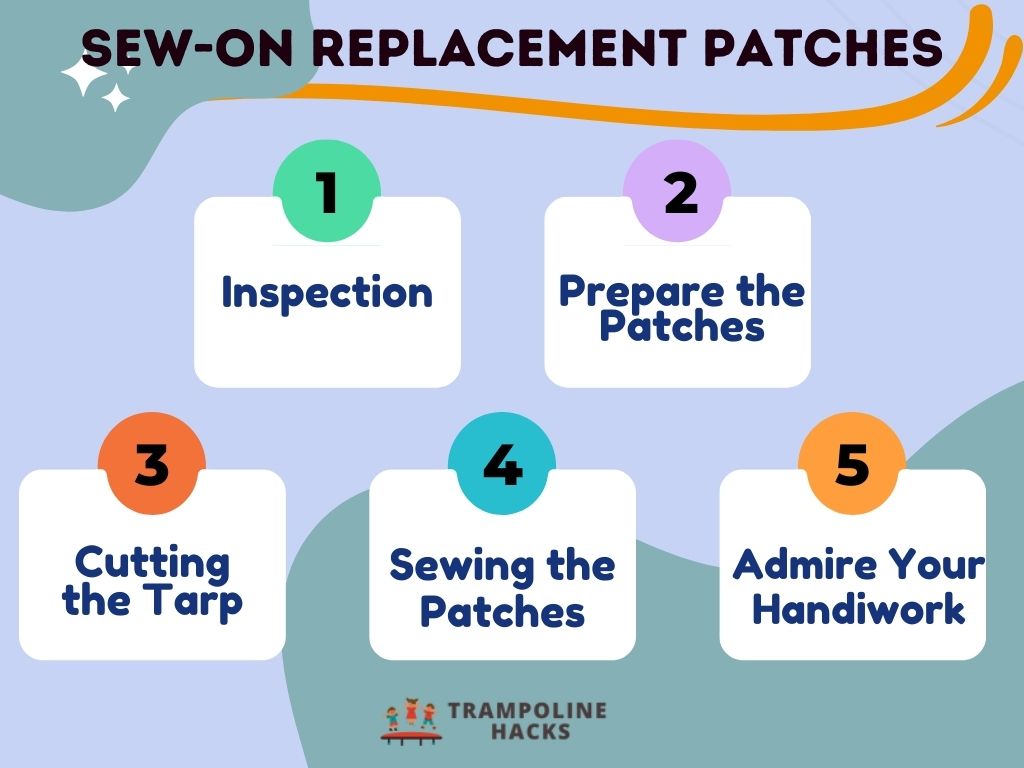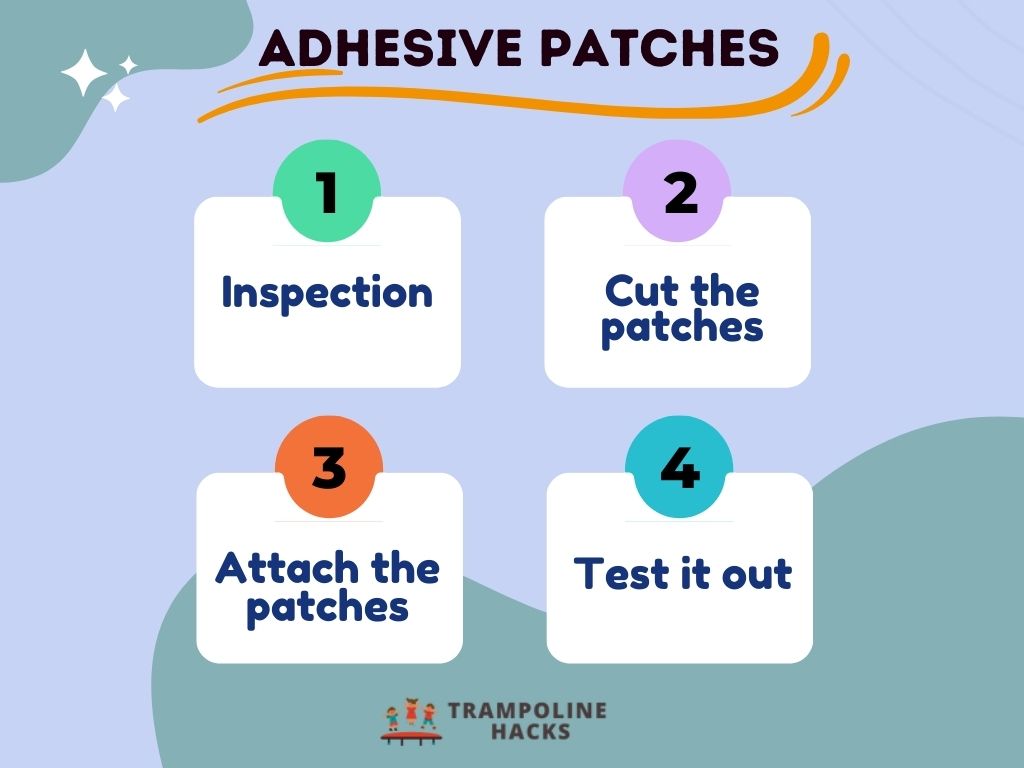Can You Jump On A Trampoline With A Hole In It? [Short Solutions]
Trampolines, in general, are designed to take a beating. For years I have kept my trampoline out in the backyard, where it rests at the mercy of the weather lords. And for years, it has stayed strong without any complaints. But a few months back, I noticed two small holes on the jumping mat.
Naturally, I was a bit worried. Since my kids use the trampoline, I would not want to put them at risk. So, I wondered whether or not you can jump on a trampoline with a hole in it. Short answer – yes, if the hole is small, but it’s still dangerous. So, you shouldn’t do it even if it’s possible.

Afterward, my first thought was to replace the jumping mat and be done with it. But before that, my friend suggested trying my hand at repairing it.
Long story short, I managed to patch up the hole, and it held up perfectly to this day. But that got me thinking. How many others like me thought of replacing a jumping mat when it could be repaired easily? Or rather, how many out there even had the idea of repairing the trampoline with a hole in it?
Check What size trampoline do i need
That is what brings me here today. I will talk about whether you can jump on a trampoline with a hole in it and how you could repair it yourself if you ever need to.
Can You Jump on a Trampoline with a Small Hole?

While it might be considered safe to jump on a trampoline with a small hole, I would not recommend it. The truth is, as you keep bouncing up and down on the jumping mat, the hole will get bigger and bigger. You might not even notice it at first. But after a couple of weeks, the hole will become too big to ignore.
At that point, you might not even be able to repair it and can only throw it away. And replacing a trampoline jumping mat is not as cheap as repairing a small hole. So my advice is whenever you notice a small hole in the jumping mat of your trampoline, get it fixed as soon as you can.
Is it Safe to Use a Trampoline with a Hole in it?

I know it can be tempting to keep using your trampoline if the hole is small, but I would strongly advise against it. There are some dangers to using a trampoline that has a hole or two on the jumping mat. For example –
Check Can you put normal trampoline in the ground
1. Ripped Mat:
The biggest problem with using a trampoline that has a small hole is that the mat can get ripped. It does not take long for a small hole on the trampoline to become large. And frequently using it can put a lot of pressure on the jumping mat, causing it to rip open.
When a trampoline mat gets ripped, there is no way back. You can try sewing it back together, but most, including myself, agree that it is best to throw it away at that point. Even if you get it stitched professionally, it can tear apart when you least expect it.
2. Broken Spring:
When there is a small hole on the jumping mat, it can affect how the spring and tension work throughout the trampoline. The weight distribution gets uneven, and the spring has to compensate. In extreme conditions, the spring of the trampoline can pop out or even break when someone is bouncing on it.
3. Damage to the Trampoline:
Other components of the trampoline can also get damaged if you insist on using a trampoline with a hole in it. You can even damage the frame of the trampoline as the weight distribution becomes uneven.
Check Can you jump robe on a trampoline
Typically, a trampoline frame is held together by bolts and screws. And because of uneven pressure, the screws can get bent quite easily. Sure, you can replace the screws, but most trampolines use very specific screw sizes that can be hard to find. If you ask me, there is absolutely no reason to risk it.
Can You Patch a Small Hole in a Trampoline?
Yes, you can. Trampoline mats, though made exceptionally strong, are susceptible to natural wear and tear over time. So it is natural for the mat to get a couple of small holes here and there.
There are many trampoline repair services out there that can bring back your trampoline from the brink of extinction. And if the size of the hole is small enough, you might even be able to repair it yourself.
How to Fix a Hole in a Trampoline?
As I have said already, if the hole is not too big, you might be able to repair it yourself, extending its lifespan by quite a bit. But if the hole gets too large, you might want to replace it instead of trying to fix it. There are two reasons for it –
Check can you have a trampoline without a fence
- The trampoline mat can tear up again even if you fix it
- It is really not worth the hassle.
But if the hole size is small enough, you can repair it to some extent. With some luck, you will be able to keep using the trampoline for a good long while before you need to think about replacing it.
In my experience, there are five ways to fix a hole on your trampoline jumping mat. Let me give you a quick rundown of each of the methods so that you can decide for yourself which one suits you best.
Method – 1: Sew-On Replacement Patches

Sew-on replacement patches for trampolines are available in many shapes and sizes and offer the best durability of all methods that I will talk about. However, these patches are a bit complicated to use and require the user to have some knowledge about stitching.
Thankfully, most of these kits come with an instruction manual to help guide you through the process. If you follow along with the guide and do not rush, you should be able to get through it without too much trouble.
Let me give you a quick rundown of the basic steps that you have to follow if you want to use sew-on replacement patches to repair trampoline holes.
Step 1: Inspection
You want to start off by taking a closer look at your trampoline mat and figuring out the extent of the damage. Then, take white chalk and draw circles around the holes so that you can see them easier.
Step 2: Prepare the Patches
Sew-on patches come as strips that you need to cut down to size. Make sure you cut the patches so that they are at least two inches wider than the diameter of the hole. You can use basic scissors to cut the patches to your desired size.
Step 3: Cutting the Tarp
Take the material that you want to use on the jumping mat, preferably a tarp fabric, and measure its dimensions using a tape measure. You want the tarp to be slightly larger than the hole so that it can cover it entirely.
Step 4: Sewing the Patches
Before you sew in the patches and tarp fabric to the mat, use some pins to hold it in place over the hole. Then, using a needle and thread, stitch the patch and tarp to the mat around the hole. Make sure you are using high-quality threads that have fantastic tear resistance when you are sewing the patches.
As for sewing techniques, go with either cross stitch or whip stitch. These two sewing methods offer the best tear resistance. While it might be okay to stitch on just one side of the jumping mat, I would suggest sewing both sides. It would make the mat stronger and more resistant to tearing in the future.
Step 5: Admire Your Handiwork
Once you have sewn the tarp and patches to the hole, use a damp cloth to clean the surrounding area. Carefully check the stitching and see if there are any inconsistencies. Before you allow the kids to start jumping on the trampoline, do a couple of tests jumps yourself and see if the stitching holds.
If you followed the instructions, your trampoline should be good to use without any issues.
Method – 2: Adhesive Patches

A popular and arguably, easiest way to repair small holes on your trampoline mat is to use adhesive patches. If you scour your local stores, you can find many adhesive patch kits to repair trampoline holes.
These kits are pretty easy to use and can work well for small holes. However, if the hole is large, it might not work as well.
The steps to using adhesive patches are quite simple. You do not need to know how to stitch and sew fabrics for this method, which is a lifesaver for people like me. And this method is also pretty durable as long as the damage is not too severe.
Here are the steps:
Step 1: Inspection
The first step is pretty much the same whether you are using sew-on replacement patches or adhesive patches; inspect the damage. Find the holes around the jumping mat and mark them using white chalk so that you can find them easily.
Step 2: Cut the patches
For the next step, you want to cut out two pieces of adhesive patch for either side of the mat. Make sure the diameter of the patch is slightly larger than the size of the hole.
Step 3: Attach the patches
Finally, attach two patches to either side of the hole, making sure there is no gap in the trampoline mat. The patches come with adhesive backing, so they should attach to the mat pretty easily.
Some patches require you to heat it up for the glue to activate. If you happen to end up with those patches, use a hairdryer to heat up the glue.
Step 4: Test it out
Once the glue has dried, your trampoline should be ready for use. Though these patches are quite good for small holes, you would not get a good performance out of them if the hole is too large. For larger holes, I would recommend going with the sew-on replacement patches method.
Method 3: Sewing Machine
Trampoline jumping mats are quite elastic, and you can use that to your advantage. If you have a sewing machine at home, you can use it to repair holes larger than 3 to 4 inches. But a fair warning to those who haven’t used a sewing machine before, it does take a fair bit of practice.
To sew up the jumping mat using your sewing machine, make sure you are using heavy-duty threads that have some UV-resistant capabilities. You want to make strong jig-jag stitches around the hole to make sure the stitching holds when you later jump on it.
Though this method is time-consuming, it is the most effective one for repairing holes on a trampoline mat.
Method – 4: Using Flex Tape
For a quick fix, you can also use flex tape. But then again, it only works for small holes on a trampoline mat. If you use it on a larger hole, the tape might not hold up well in terms of strength.
You have a lot of different options when you are buying flex tape to repair trampoline holes. The best thing about this type of tape is that they work well even in wet conditions. So the tape should stay strong even when you leave your trampoline out in the rain.
Method 5: Get Professional Help
If you would rather not take any hassle on yourself, you can, of course, always hire a professional to get the job done. You can call your local trampoline shop and ask for a repair, and there is a good chance that they will help you out.
The best thing about this method is that you do not need to worry about damaging the trampoline mat further. If the mat is repairable, the professional can do the job for you. The drawback, on the other hand, is that the service might not be that cheap depending on the size of the hole.
Tips to Protect Your Trampoline Mat
The honest truth is, if you can prevent holes in your trampoline mat, it is always better than having to fix it. Trampoline mats do not last indefinitely. But there are ways to extend its lifespan with a bit of care.
Here are a couple of tips to help you keep your trampoline mat safe and hole-free.
- The first tip I can give you is to install your trampoline on even ground. While there are ways to set up a trampoline on uneven ground I would not recommend it. If possible, even ground is always the best terrain to set up your trampoline as it does not put extra pressure on the trampoline mat.
- Another handy piece of advice that my friend actually gave me is to avoid using shoes on the trampoline mat. The sole of the shoe can often tear the rubber mat, and if you can avoid wearing shoes on the trampoline, your mat will be protected longer.
- You should also think about where you are placing the trampoline. If there is a large tree above the trampoline, sharp branches can break off during a storm and fall straight on the trampoline mat. It can easily rip a hole in your trampoline.
- On hot summer days, if you are not using the trampoline, it is a good idea to cover the mat with a tarp. Typically, trampoline mats can resist UV rays. But a bit of extra protection never hurts.
- You should periodically inspect and clean the trampoline. That way, your trampoline mat will last longer, and even if there is a small hole on the surface, you can detect it before any accidents.
- If you are not planning on using the trampoline for a long time, for example, during the winter, it might be a good idea to disassemble it and store it away. During the winter, the freezing temperature outside can also damage your trampoline. Ideally, you do not want to use your trampoline during winter.
- I have already covered spring sizes and their relation to trampoline sizes in this article. Lastly, make sure you are using the right size of springs for your trampoline. It can give you some insight into the proper sizes when you need to replace old springs in your trampoline.
With All That Said
If you have the patience for it, trampoline hole repair is really not that difficult for people who have some basic sewing skills. Adhesive trampoline repair patches can also make it easy for you to repair trampoline holes if you are not confident in your sewing technique.
But one thing is for certain, the moment you notice small holes in your trampoline, stop using it. Trampoline accidents are pretty common, and you are not doing yourself any favors by using a faulty trampoline. Fix it, and be done with it. Good luck!
Hi, It’s Jason and Louise here and welcome to our website. We are parents to Hannah and Zachary who absolutely love the outdoors and are actually addicted to jumping on their trampoline. Our amazing little family lives on a beautiful 20-hectare rural property with Horses, Dogs, Cats, Chooks, a Rooster, Cats and also a Pet Kangaroo.